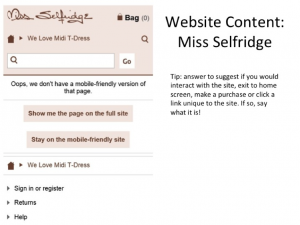Focus group results: the importance of a streamlined user experience
Having recently completed my degree in Digital Marketing Communications at Manchester Met University, I have this useful piece of research laying around. Instead of having it sit there, benefitting no one, I thought I would repurpose some of the insights as blog posts to share with you lovely people. This is part one…
Entitled ‘Mobile responsive design – retaining customers with delightful content, anywhere’, the research looked into the effects that web and email render quality has on user behaviour and the implications for brands. As well as interviewing 4 industry professionals, the study also questioned two focus groups of students. The aim here was to identify themes in how users interact with different levels of (website and email) quality from a mobile device.
Below are themes that I identified from the focus groups and some quotes to support each insight. There were no ground breaking findings that I hadn’t predicted but it does show how regular consumers interact with everyday emails/sites on their mobile devices. Examples are not displayed with the comments in order to protect the identity of the brands. Above is an example of a medium quality site and click through that the groups were presented with.
Trend 1: The lower the quality of content, the more likely the user is to exit or unsubscribe.
“I personally wouldn’t know what to do with this email. I usually would give up if it took too long to load on my mobile but I might open it again later on my laptop. It doesn’t look like it’s supposed to be viewed on a small screen.” – Low quality example
Trend 2: The higher the quality of content, the more likely the user is to interact (click through, add to basket or browse site).
“The site looks pretty straightforward. If I was viewing it on my phone I would add it to my basket if that is what I was looking for.” – High quality example
“I would probably either buy right there and then or find it later on my laptop (but only because I’m funny with purchasing stuff on my mobile).” – High quality example
Trend 3: If the content was responsive but not easy to interact with (medium quality) the user was more likely to view on a desktop or abandon all together than stay and interact.
“If I had clicked through from an email to arrive at a site which couldn’t find the product I had shown an in interest in I would definitely exit the site. The company comes across as unprofessional and disorganised.” – Medium quality example
“It really annoys me when companies advertise products clicking them doesn’t reveal what you expect it to. If I wanted the product enough I would try and find it on a desktop later but wouldn’t waste any more time on my mobile.” – Medium quality example
The underlying trends include the importance of speed (a factor that isn’t usually controlled by the sender), consumer expectations of click throughs and mobile security. However, for this study the concentration was on the the loyalty and behaviour of the consumer based on the quality of brand interaction. The study concluded that the quality of user experience is extremely important in order to determine whether a customer converts, returns or interacts with a company.
So brands, if it isn’t already a priority, get to know your consumers wants and expectations of your online presence but most importantly, ‘deliver delightful’.
